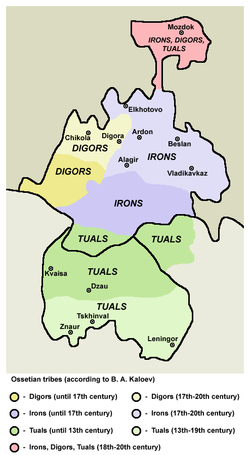Digorænttæ | |
|---|---|
 | |
| Total population | |
| ~200,000 | |
| Regions with significant populations | |
| est. 100,000 | |
| unknown | |
| 700 (2013)[a][1] | |
| Languages | |
| West Ossetian | |
| Religion | |
| Majority: Minority: | |
| Related ethnic groups | |
| other Iranian peoples, Balkars | |
| |

The Digor or West Ossetians (Ossetian: Дигорæнттæ, romanized: Digorænttæ,[6] pronounced [digɔːrɐ, digɔːrɐnttɐ]) are a subgroup of the Ossetians (Alans). They speak the Digor dialect of the Eastern Iranian Ossetian language, which in USSR was considered a separate language until 1937. Starting from 1932 it is considered just a dialect of Ossetian language. The speakers of the other dialect - Iron (East Ossetian) - do not understand Digor (West Ossetian), although the Digor usually understand East Ossetian, as it was the official language of the Ossetian people and officially taught in schools. In the 2002 Russian Census 607 Digors were registered,[7] but in the 2010 Russian Census their number was only 223.[8] It was estimated that there are 100,000 speakers of the dialect,[9] most of whom declared themselves Ossetians. The Digor mainly live in Digorsky, Irafsky, Mozdoksky districts and Vladikavkaz, North Ossetia–Alania, also in Kabardino-Balkaria, Turkey and Syria.
- ^ "First Ethnic Ossetian Refugees from Syria Arrive in North Ossetia". Jamestown. Retrieved 2022-10-16.
- ^ Minahan, James (2012). Miniature Empires: A Historical Dictionary of the Newly Independent States. New-York: Routledge. p. 211. ISBN 978-1-57958-133-6.
- ^ "Ossetian Digorians. The mystery of the origin of iriston, digoras and the great tamerlane".
- ^ "Archived copy". Archived from the original on 2017-02-05. Retrieved 2017-02-04.
{{cite web}}: CS1 maint: archived copy as title (link) - ^ http://s50.radikal.ru/i129/1003/22/2fec9d793e3d.jpg [bare URL image file]
- ^ Камболов, Тамерлан Таймуразович (2006). Очерк истории осетинского языка. Владикавказ: Ир. p. 410.(in Russian)
- ^ "Russian Census 2002: Population by ethnicity" (in Russian). Archived from the original on 29 February 2016. Retrieved 19 April 2014.
- ^ "Russian Census 2010: Population by ethnicity" (PDF) (in Russian). Retrieved 19 April 2014.
- ^ "Digor in Russia". Joshua Project. Retrieved 17 May 2014.